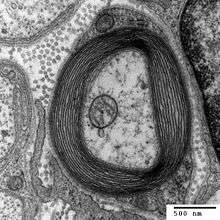Hereditary neuropathy with liability to pressure palsy
| Hereditary neuropathy with liability to pressure palsy | |
|---|---|
 | |
| Nerve with myelin sheath | |
| Classification and external resources | |
| ICD-9-CM | 343 |
| GeneReviews | |
Hereditary Neuropathy with Liability to Pressure Palsy (HNPP) is a peripheral neuropathy, a disorder of the nerves. HNPP is a nerve disorder that affects the peripheral nerves,[1]—pressure on the nerves can cause tingling sensations, numbness, pain, weakness, muscle atrophy, and even paralyzation of affected area. In normal individuals these symptoms disappear quickly but in sufferers of HNPP even a short period of pressure can cause the symptoms to occur. Palsies can last from minutes, days to weeks, or even months.[1][2]
The symptoms may vary—some individuals report minor problems, whilst others experience severe discomfort and disability. In many cases the symptoms are mild enough to go unnoticed. The time period between episodes is known to vary between individuals. HNPP has not been found to alter the lifespan, although in some cases a decline in quality of life is noticed. Some sufferers (10-15%) report various pains growing in severity with progression of the disease.[2] The nerves most commonly affected are the peroneal nerve at the fibular head (leg and feet), the ulnar nerve at the elbow (arm), and the median nerve at the wrist (palm, thumbs and fingers), but any peripheral nerve can be affected. HNPP is part of the group of hereditary motor and sensory neuropathy (HMSN) disorders and is linked to Charcot–Marie–Tooth disease (CMT).
Symptoms/signs
Among the signs/symptoms of hereditary neuropathy with liability to pressure palsy are the following (different symptoms are caused by different nerves, such as the foot drop is caused by the peroneal nerve[1]):
Causes

Hereditary neuropathy with liability to pressure palsy is an autosomal dominant genetic disease (which means one parent must be affected[6]).[7] A mutation in one copy of the gene PMP-22 (Peripheral myelin protein 22, 17p11.2) that makes the peripheral myelin protein causes haploinsufficiency, where the activity of the normal gene is insufficient to compensate for the loss of function of the other gene.[8]
Molecular biology/genetics

Peripheral Myelin Protein 22 gene entails about 5% of the PNS myelin,[9] it is located on chromosome locus 17p12[10]
Overlap with Charcot-Marie-Tooth disease type 1A has been found in Gly94fsX222 (c.281_282insG), due to point mutations of PMP 22 that occur in a minority of cases of hereditary neuropathy with liability to pressure palsy. The point mutations -missense, nonsense and splice-site have each been alluded to in HNPP.[11]
Diagnosis
In terms of diagnosis of HNPP measuring nerve conduction velocity may give an indication of the presence of the disease.Other methods via which to ascertain the diagnosis of hereditary neuropathy with liability to pressure palsy are:[1][5]
- Family history
- Genetic test
- Physical exam(lack of ankle reflex)
Treatment
There is no current treatment, however management of hereditary neuropathy with liability to pressure palsy can be done via:[5][11]
- Occupational therapist
- Ankle/foot orthosis
- Wrist splint (medicine)
- Avoid repetitive movements
History
Inherited PNS disorders were first described by Charcot, Marie and Tooth (1886). De Jong (1947) first described HNPP in a Dutch family. Dyck and Lambert (1968) showed nerve conduction studies, and Chance et al. (1993) detected the chromosome deletion in most of the individuals with the HNPP condition.[4][11][12]
See also
References
- 1 2 3 4 5 Bird, Thomas D. (1 January 1993). "Hereditary Neuropathy with Liability to Pressure Palsies". GeneReviews(®). University of Washington, Seattle. Retrieved 6 August 2016.update 2014
- 1 2 "Hereditary Neuropathy with Liability to Pressure Palsies". April 2007.
- ↑ "OMIM Entry - # 162500 - NEUROPATHY, HEREDITARY, WITH LIABILITY TO PRESSURE PALSIES; HNPP". www.omim.org. Retrieved 18 August 2016.
- 1 2 3 RESERVED, INSERM US14 -- ALL RIGHTS. "Orphanet: Hereditary neuropathy with liability to pressure palsies". www.orpha.net. Retrieved 18 August 2016.
- 1 2 3 4 "Hereditary neuropathy with pressure palsies (HNPP)". NHS. NHS.uk. Retrieved 18 August 2016.
- ↑ "Autosomal dominant: MedlinePlus Medical Encyclopedia". medlineplus.gov. Retrieved 18 August 2016.
- ↑ Kuhlenbäumer, G.; Stögbauer, F.; Ringelstein, E. B.; Young, P. (2006-01-16). Hereditary Peripheral Neuropathies. Springer Science & Business Media. pp. 96, 126. ISBN 9783798515864.
- ↑ Vallat, Jean-Michel; Weis, Joachim; Neuropathology, International Society of (2014-10-20). Peripheral Nerve Disorders: Pathology and Genetics. John Wiley & Sons. ISBN 9781118618431.
- ↑ "OMIM Entry - * 601097 - PERIPHERAL MYELIN PROTEIN 22; PMP22". omim.org. Retrieved 2016-08-18.
- ↑ mapview. "Map Viewer". www.ncbi.nlm.nih.gov. Retrieved 2016-08-18.
- 1 2 3 van Paassen, Barbara W; Kooi, Anneke J van der; Spaendonck-Zwarts, Karin Y van; Verhamme, Camiel; Baas, Frank; Visser, Marianne de (19 March 2014). "PMP22 related neuropathies: Charcot-Marie-Tooth disease type 1A and Hereditary Neuropathy with liability to Pressure Palsies". Orphanet Journal of Rare Diseases. 9 (1). doi:10.1186/1750-1172-9-38. ISSN 1750-1172. Retrieved 18 August 2016.
- ↑ Sango, Kazunori; Yamauchi, Junji. Schwann Cell Development and Pathology. Springer Science & Business Media. p. 83. ISBN 9784431547648. Retrieved 18 August 2016.
Further reading
- Horowitz, S. H.; Spollen, L. E.; Yu, W. (1 November 2004). "Hereditary neuropathy with liability to pressure palsy: fulminant development with axonal loss during military training". Journal of Neurology, Neurosurgery & Psychiatry. 75 (11): 1629–1631. doi:10.1136/jnnp.2003.029314. ISSN 1468-330X. Retrieved 18 August 2016.
- Lorenzoni, Paulo J.; Scola, Rosana H.; Cardoso, Juliana; Kay, Cláudia S.K.; Fugmann, Elmar A.; Marques Jr, Wilson; Silvado, Carlos E.; Werneck, Lineu C. (December 2008). "Swallowing dysfunction in hereditary neuropathy with liability to pressure palsies". Arquivos de Neuro-Psiquiatria. 66 (4): 898–900. doi:10.1590/S0004-282X2008000600027. Retrieved 18 August 2016.